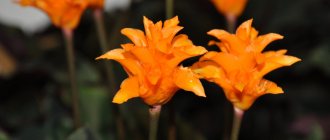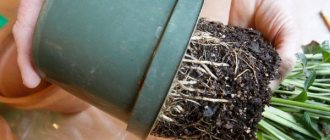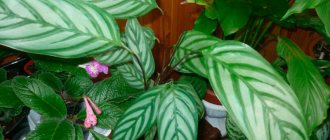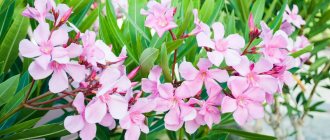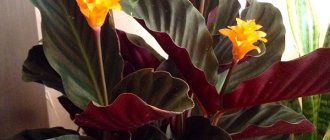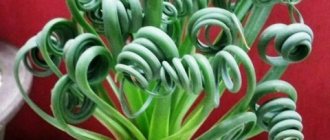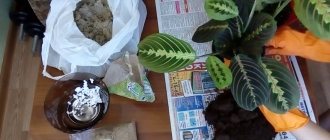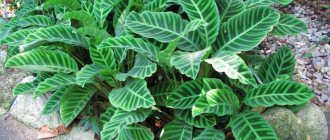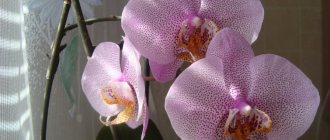Calathea is a herbaceous perennial rhizomatous plant. Calathea came to the apartment greenhouses of gardeners from the tropical regions of America. This is an amazing, chic flower, whose foliage, like the plumage of strange birds, causes dizzying delight among connoisseurs of the plant world. The leaves are unusually showy: covered with bright veins or spots, which in some cases have a geometric shape. When you look at the calathea, the question arises, what kind of creator created such beauty and painted the leaves of this bizarre plant with a tiny brush.
Flower growers have nicknamed members of the Marantaceae family prayer plants for their rare ability to lift and join leaves in the evening and before rain. Unique leaf pads-thickenings at the bases of the leaves enable the plant to follow the sun's rays throughout the day.
Connoisseurs of fresh flowers can choose several wonderful plants from the arrowroot family for home cultivation. The most common are ctemantha, stromantha, arrowroot and calathea.
Calathea bachemiana
Currently, this type is one of the most popular. Its natural habitat is the tropical forests of Brazil. Calathea Bachema is distinguished by its unpretentiousness when compared with other representatives of the genus. In addition, it has quite bright decorative features.
It has lanceolate leaves, without a petiole. Reaches 35 cm in height. The width of the leaves is about 7-8 cm, and the length is 15-20 cm. Towards the top they narrow sharply. They have a dense leathery structure. The upper side of the leaf blade is light green, with a bright silvery tint. There is a dark green border along the edge of the plate. The underside is somewhat darker and monochromatic. A characteristic feature of the species is a pattern of dark spots or stripes running along the central vein.
Cream flowers are located on short pedicels, the length of which does not exceed 2.5 cm, and are collected in small, about 6 cm in length, spike-shaped inflorescences. After flowering, the plant often loses the entire above-ground part, but after a while new shoots appear. But in indoor conditions, Calathea Bachema practically does not bloom.
Diseases and pests of calathea
Calathea can suffer from fungal diseases. They develop at low temperatures or in a hot, humid room when water stagnates in the soil. Infection with the fungus Rhizoctonia can destroy the flower. The cause is excessive watering and the appearance of root rot. Fungal infections leave virtually no chance for the plant to continue to develop. Saving a plant is very difficult. The plant must be replanted after pre-treating it with a fungicide. It is known that weak, diseased plants are especially susceptible to pests.
If the maintenance conditions are violated, scale insects settle on the plant. They are stationary on the back of the leaves, drawing juice from the leaves. The leaves turn pale and fall off, the shoots die. In order to avoid plant loss, it is necessary to immediately begin pest control. Scale insects are recognized by the presence of an adhesive layer on the leaves. Sooty fungus settles on this sticky layer. It is difficult to collect scale insects manually, so the plant is treated with karbofos four times.
Spider mites also live on the back of leaves. You can understand their presence by noticing that the leaves of the calathea are drying. The infestation of a crop by spider mites indicates poor air humidity in the room.
If the plant is over-watered, the root system may rot, and the pest Thrips will also appear. Signs of its appearance are expressed in white spots on the surface of the leaves. The insect itself is located on the back side of the leaf and eats it from the inside. The white spots subsequently dry out, crumble, and holes form in their place. The plant ceases to be attractive. The fight against harmful insects is carried out using special preparations, ensuring good ventilation in the room.
You can also get rid of pests using folk remedies, for example, spraying at least 3 times a day with hydrogen peroxide (1 tablespoon per 5 liters of water).
Plant and herbal tinctures strengthen plants, increase their durability and resistance to diseases and fungi, and nettle may be the best solution. Its cold water extract is a proven remedy over the years.
It must be remembered that timely care of cultivated plants helps them resist the attacks of pests and diseases, and if infected, cause relatively little damage.
Calathea lubbersii
This species is native to the tropics of Central America. Calathea Lubbersa can grow up to 80 cm in height. The leaves are large (up to 30 cm in length), quite wide. They have an oval shape and are located on long petioles. Also a distinctive feature of Calathea Lubbers is the asymmetry of the pattern. The main color of the leaf blade is bright green, with large spots of light green or light yellow on it.
Calathea of this species also stands out among others by the color of the underside of the leaf. It has a green tint, while in most species the underside of the leaf is painted in red shades. Has a uniform color, without spots. Often slightly lighter than the upper side. At home it blooms extremely rarely. The flowers are orange in color.
The most popular home varieties
Currently, there are a little more than two dozen varieties, the planting material of which is easy to find on sale. Among them, the following stand out:
Calathea saffron
Saffron Calathea (Calathea crocata). A small (about 40 cm in height), compact plant, the decorativeness of its leaves is much inferior to its relatives. Its peculiarity is that it is the only cultivated species of calathea that regularly blooms at home.
Calathea is wonderful
Wonderful Calathea (Calathea lancifolia, Calathea insignis). It is distinguished by long (up to 45 cm in length) narrow lanceolate leaves. They are dense, opaque with a pattern, in the form of oval spots of different sizes, diverging to the sides from the central vein.
Calathea Makoya
Calathea makoyana. Grows in height up to 60 cm and above. Along the green front greenish-white side there is a pattern of stripes and spots of different shapes, sizes and shades of green.
Calathea orbifolia
Calathea orbifolia. Grows up to 40-60 cm. The leaves have an almost regular rounded shape. Stripes diverge on both sides of the central vein, forming a very beautiful striped pattern on the surface.
Calathea medallion
Calathea medallion (Calathea roseopicta) or pink-colored calathea. A compact plant, rarely exceeding dimensions of 30x30 cm. The leaves are oval-ovate, with a clear pattern (different depending on the variety) and clearly visible reddish veins.
Kalathea Varshevich
Calathea Warscewiczii. A large plant, reaching a height of up to 1 m. The leaves are velvety, in the shape of an elongated oval, with a pattern symmetrical relative to the central vein, painted in several shades of green. With good care it can bloom at home.
Calathea network
Calathea network or Calathea musaica. A low, spreading bush with a pronounced personality. The pattern on the smooth, spear-shaped leaves resembles a mosaic or mesh. It takes root in an apartment better than other species and survives wintering.
Calathea zebrina
Calathea zebrina. A slender plant, up to 60 cm high, with large oval or ovate leaves with a velvety surface. The pattern consists of dark and light stripes extending to the sides from the central vein, vaguely reminiscent of the pattern on the skin of a zebra.
Calathea decorated
Calathea ornate. Grows up to 80 cm in height. It is distinguished by large, elliptical leaves up to 25 cm in length. Thanks to its colorful, spectacular pattern of fine lines, it is considered one of the most decorative species and has several forms, the most popular of which is Calathea ornate 'sanderiana'.
Calathea rufibarba
Calathea rufibarba or red-bearded calathea. Reaches up to 1 m in height. The name is due to the red fluff on the back of the lanceolate, erect leaves. The pattern on them is either absent or not clearly expressed.
Calathea Bachema
Calathea Bachemiana. It is considered one of the most difficult to care for. Grows up to 40 cm. It is distinguished by large (up to 25 cm in length) leathery leaves and lanceolate leaves. The pattern on them resembles a neat dark green twig on a light green background.
Calathea picturata
Calathea picturata or painted calathea. Grows up to 35–40 cm. The leaves are regular oblong oval in shape with a pointed tip, the underside is purple, the upper side is silver with a dark green border. It appears as if a smaller leaf has been painted with silver paint on the dark green leaf. At temperatures below 16 ° C it dies. C. Picturata has been awarded the annual Garden Merit award, which means it is recommended by the Royal Horticultural Society for indoor growing.
Calathea silver
Silver calathea (calathea argyraea). The first scientific description of this species was given in 1862. A compact plant with small oval-shaped leaves with a pointed tip. Their distinctive feature is an unusual silvery tint. The front side is barely noticeably corrugated with light transverse veins, which diverge parallel to each other to the sides from the center. There is a very thin green border along the edge. The back side and petioles are painted purple.
Calathea Helen Kennedy
Calathea Helen Kennedy. It was first discovered and described by the English botanist Helen Kennedy in Panama. A low, compact plant with small oval leaves. Their vibrant and complex patterns make them resemble peacock feathers. The front side is painted emerald green and silver, the back side and petioles are raspberry pink. It blooms with small yellow spike-shaped inflorescences.
Calathea white star
Calathea white star, also called calathea majestica and majestic calathea albolineata. It was first described in 1986 by H.A. Kenn. Can grow up to 1 meter in height. Large lanceolate glossy leaves are located on long petioles. The underside of the leaf is beet red, and the upper part is dark green with white, sometimes pinkish-white, streaks.
Calathea beauty star
Calathea beauty star. Lush compact plant. Due to its small size and large, dense green mass, its stem is completely invisible. The leaves are medium-sized, oval, slightly elongated with a pointed tip, divided into two halves by a thin light green vein. The pattern on the outside resembles bright lime feathers painted on a dark green background. The back side and short petioles are purple-violet.
Calathea flamestar
Calathea flame star. The compactness and lushness of the bush, as well as the shape of the leaves, resembles c. beauty star But its smooth glossy leaves are larger, and their pattern is even more intricate - a complex, multi-stage edging runs along the wavy edges. Overall, the design looks as if the edges of the leaves are on fire, justifying the name “Flaming Star.” The upper side of the leaves is dark green with bright light green feather-like strokes, symmetrically diverging to the sides from a thick light green vein. The lower one, like the short petioles, is purple-beetroot.
Calathea vicha
Calathea Veitchiana or Veitcha. A tall plant, reaching a height of up to 1 m. This species was discovered in 1862 in Ecuador by botanist Richard Pierce and named it after his employer, the famous British gardener James Wyche. The leaves of Calathea Vicha are large, dense, glossy, oval in shape, with a pointed tip, wavy edges and a heart-shaped base, growing on long petioles. The front side is tricolor: yellowish-green, dark green and white with a complex pattern. It seems that another smaller sheet is drawn on top of the main sheet. Its contours can also be seen on the underside of the purple side. Under natural conditions it blooms with small white or cream spike-shaped inflorescences with greenish bracts.
In 1983 in Peru N.A. Kenn described a new species of Calathea that has the same leaf pattern and was previously misidentified in collections as C. Veitchiana. This new species was named C. pseudoveitchiana. Calathea Pseudoveichiana has a thick green border around the edges, and the pattern can consist of several colors. The varieties in which the pattern consists of white and red colors, and the frame has a bright green color, look especially bright. The pattern itself is similar to Veitch’s Calathea pattern, only the “drawn” leaf has a double frame: a common one around the edge and a reddish-green inside.
Calathea Litze
Calathea Lietzei. Grows up to 60 cm. The leaves are shaped like an elongated ellipse, with a slightly wavy edge, a pointed tip and a heart-shaped base, growing up to 15 cm in length and 6 cm in width. The front surface is smooth, glossy with a metallic sheen and a symmetrical pattern in the form of yellow-green strokes on a dark green background, extending to the sides from the central vein. The back side and long petioles are violet-lilac. In nature it blooms with small, inconspicuous, white, spike-shaped inflorescences.
Calathea Freddy
Calathea Freddy. A compact ornamental indoor plant up to 40 cm high. Smooth, lanceolate-shaped leaves with a slightly wavy edge grow on long petioles. The upper side of the leaf is painted in a pastel whitish-green background, on top of which there is a dark green pattern in the form of a branch with leaves extending to the sides from the central vein. The edges of the leaves are framed by a neat thin dark green border. This pattern is also visible on the lower, purple-lilac side. Does not bloom at home.
Calathea Bicajou Gecko
Calathea Bicajoux Gecko. It stretches up to 50 cm in height. It is distinguished by large, dense, glossy leaves growing on long petioles. The pattern of the leaves is unusual: it seems that on a large silvery-greenish leaf there is another smaller emerald green leaf, or a dark green lizard perched. The underside of the leaves is reddish in color. Calathea Bicajou is one of the few that blooms indoors. The small, spike-shaped pink flowers bloom mainly in the summer over a period of 8 weeks.
Calathea Louise
Calathea Louisae. It grows in height up to 40-80 cm. The leaves are large, thin, lanceolate, with a slightly wavy edge, up to 22 cm long and up to 10 cm wide, sitting on long petioles. The outer side is painted in three shades of green, which run in stripes, reminiscent of careless brush strokes, from the central vein to the edges. The back side is lilac-violet. At home it blooms reluctantly, with small white flowers with greenish bracts, collected in spike-shaped inflorescences. In this case, the flowering stem is much shorter than the petiole.
Calathea queen Maui
Calathea Louisae 'Maui Queen' is one of the varieties of Calathea Louisae. A very impressive plant with large dark green leaves on long petioles. Along the entire length of the plates along the middle vein there are white spike-like strokes. The reverse side is lilac-violet. Grows up to 50-60cm.
Calathea Lubbersa
Calathea Lubbersii. A spreading bush that grows up to 60-80 cm. It is distinguished by its shape and leaf color, which is atypical for Kalatas. Smooth, glossy, oblong, they grow on very long petioles. They do not have a symmetrical pattern, like most representatives of the genus, but a chaotic pattern, consisting of yellow spots of different sizes, diverging in random order from the central vein along a bright green surface. In addition, the underside, like the petioles, is not reddish or purple, but green.
Calathea white tiger
Calathea fusion white. A very spectacular plant, capable of growing up to 70-80 cm. The leaves of Calathea white fusion are distinguished by an unusual, memorable marble color, consisting of white and several shades of green. The leaf blades are large, oval, with slightly curved edges in different directions, and grow on long purple petioles. On the reverse side of the plates there is also a marble pattern, but in shades of pink, lilac and violet.
Calathea leopardina
Calathea leopardina. It grows up to 40-50 cm. Calathea Leopardova is distinguished by elliptical-lanceolate leaves, 3-5 cm wide and 10-12 cm long on long petioles. The upper side of the leaf blades is light green with dark green spots that follow the shape of the leaves, with the base pointing away from the midrib. It seems that a neat dark green twig is painted on a light green surface. The back of the leaves is lilac-pink. In nature it blooms with small spike-shaped yellow inflorescences.
Calathea mix
Calathea mix. Some sources mistakenly describe these calatheas as an independent species. In fact, there is no variety or type of “Mix” as such. This word must be understood in its literal translation - mixing. Calathea Mix means that different species were brought to the store mixed together, that is, this is just a designation for a mixture of plants.
Calathea lancifolia (Calathea lancifolia)
A popular species, characterized by rapid growth and relative unpretentiousness to living conditions. Natural habitat is tropical rainforests of Brazil.
The wonderful calathea reaches a height of up to 70 cm. The leaves are long and narrow, lanceolate. Their length rarely exceeds 25 cm. The width of the leaves is 3-5 cm. The edge of the leaf blade is slightly wavy.
Lanceolate calathea has bright decorative qualities. On top, the leaves are light green in color with a geometrically regular pattern of dark green ovals of small and large sizes, which alternate with each other. The underside of the leaf is dark burgundy, often mixed with a purple tint.
In indoor conditions, wonderful calathea blooms very rarely. The flowers of representatives of this species are small and inconspicuous.
Why do the tips of calathea leaves turn yellow and dry, what to do in this case
From the description of the varieties of calathea, the fact of their attractiveness and whimsicality to living conditions remains undeniable. And as soon as the slightest “demand” is not fulfilled, the plant lets you know about it in the form of diseases. That is why beginners in floriculture often encounter problematic situations when the tips of Calathea leaves begin to turn yellow and dry out. But in order to eliminate such an unpleasant “symptom” of the disease, it is necessary to understand its causes.
The leaf blades of this ornamental plant may acquire a yellowish tint at different levels. If the lower leaves begin to turn yellow, then there is no cause for concern, since this indicates the passage of the usual processes of natural rejuvenation. However, if most of the deciduous crown of the bush acquires a yellow color, then it is worth understanding the main prerequisites for such an unsafe phenomenon.
Most professional flower growers, when asked why the leaves of home calathea begin to turn yellow, give an explanation in the form of the following reasons:
- Watering was carried out incorrectly: excess or lack of moisture.
- Poor quality water was used for soil irrigation: untreated, chlorinated or cold.
- Insufficient air humidity.
- We overdid it with fertilizers.
- Cold temperature conditions.
And if it is established what led to the situation when the leaves of indoor calathea began to turn yellow, then the question of what to do will disappear by itself. After all, eliminating the causes of a disease is the recipe for its treatment! So, by normalizing the volume and composition of the liquid during watering, you can avoid the unpleasant “unhealthy leaves” syndrome. Creating the necessary stable air temperature and humidity is an important step towards the healthy shine of the deciduous crown of an exquisite ornamental shrub at home.
Calathea zebrina
This species is native to the tropical forests of South and Central America. Zebra-shaped calathea is a fairly large representative of the genus and reaches up to 80 cm in height. In rare cases, it grows up to 90 cm. This herbaceous plant has large velvety leaves (about 30-35 cm in length) of an oval shape. Their width is 15-20 cm. The upper part of the leaf blade is bright green in color. The pattern consists of dark symmetrical stripes. Because of this striped pattern, the calathea received the name “zebra-shaped”. The underside of the leaf has a light green color without stripes; over time it acquires a beetroot tint.
The plant's pedicels are short. The flowers are white or lilac in color. At home it practically does not bloom.
Calathea warscewiczii
The natural habitat of this plant is Panama, Nicaragua and Costa Rica. Calathea Varshevich is one of the most demanding species. It needs a high level of humidity (about 80-90%), such conditions are difficult to create in an apartment, especially in winter.
Calathea Varshevich grows up to 1 m in height and in diameter up to 1.5 m or more. This species has large velvety leaves (20-55 cm) of rich dark green color and oval shape. The pattern is most often relatively weakly expressed and is a light green pattern in the form of short stripes located along the central vein. The reverse surface of the leaf plate is painted pale red.
One of the main advantages of Varshevich's calathea is that it blooms at home. The flowers, like those of other representatives of the genus, are collected in spike-shaped inflorescences.
The bracts are cream-colored. The color of the flowers can be white, soft pink or pale cream. You should know that before flowering, Varshevich's calathea forms elongated, crank-curved shoots, which require support to avoid damage.
Caring for calathea at home
Everyone who grows and cares for plants for more than one year knows what measures need to be taken to prevent the plant from dying. If a person buys a plant for the first time in a flower shop, then he is not immune from the fact that his purchase will soon wither. To avoid such an unpleasant situation, it is necessary to follow some rules that will help preserve the plant, and it will continue to please its owner for a long time.
At home, caring for calathea consists of creating acceptable conditions for its development. Failure to follow the rules will destroy the exotic beauty.
If the leaves of the calathea curl and dry out, spots appear on them, then the conditions for the plant are not comfortable enough. Calathea prefers diffused light, therefore, it is necessary to shade the window panes. An air humidifier is placed near the plant, and on a hot day it is taken out into the open, into fresh air, protected from the wind. The flower suffers from drafts and gas combustion products.
The most capricious and require careful care at home are flowering varieties, especially Calathea saffron or Calathea crocata. Calathea makoya is considered the most unpretentious.
The basic principle of watering the tropical enchantress: abundantly, but not often. Tropical calathea needs high-quality care, which requires time from the grower, complete dedication and mutual understanding with the flower.
Lighting
Different varieties of calathea come from countries with warm climates, so they love sunny, sheltered places. The lighting in the room should be quite intense, but the plant should be protected from direct sunlight. Bright light is detrimental to leaves: with excessive light, they curl and their color fades. It is advisable for novice gardeners to plant a houseplant not in a ceramic, but in a plastic pot, since ceramics retain water well, and calathea suffers from this.
Top dressing
During intensive growth, from April to October, calathea at home is fed once every two weeks with liquid complex fertilizer for decorative foliage plants. During the dormant period, plants are fed once every two months.
Air humidity
It is quite difficult to provide high-quality care for calathea without additional techniques. The plant requires a high level of air humidity, not lower than 90%. To increase the humidity in the apartment, plant growers install aquariums or glass terrariums.
Plants quickly lose moisture, so the area around them must be sprayed daily with a spray bottle and the leaves periodically wiped with a damp sponge. The pot can be placed in a container with wet pebbles. It is recommended to generously spray the plant with soft water once every 2 days.
When spraying water, the main goal is to moisten the area around the plant so that a minimum of water gets on the leaves. If you deviate from this rule, brown spots will soon appear on the leaves. Spraying of species with velvety leaves is excluded; the air around them simply needs to be moistened.
The velvet representatives of the tropical beauties are created with comfortable conditions by placing the pot with the culture in a tray with expanded clay, mossy plants, and a small amount of water, so that the bottom of the flower pot does not come into contact with the liquid.
Temperature
Calathea is a heat-loving indoor plant and does not tolerate drafts. The temperature in the room should be constant: all year round not lower than +18 C, preferably +20...+25 C. The plant is affected by temperature changes, so it is not recommended to place them near an open window or door.
Watering
Throughout the year, you need to water the plant generously with soft water at room temperature. The soil should always be moist, and stagnation of water in the pot should be avoided. In summer, water every other day, and in winter, water once a week, allowing the soil to dry out between waterings. The pot with the plant is kept on a tray with damp pebbles in a cool place.
Varieties with velvety leaves are not sprayed and generally try not to get water on their leaves, as it leaves streaks. Watering is carried out carefully at the edge of the pot. To prevent the plant from getting sick, sticks with special preparations are used that kill harmful insects.
Trimming
When cared for at home, calathea flowers do not require regular pruning. Timely removal of damaged and dry leaves is necessary.
Fertilizer
Fertilizers primarily provide nutrients to plants and also maintain soil health. It is best to fertilize with a mixture of organic nutrients, for example, horn flour in combination with mineral fertilizers without lime, which is better for long-term action. In addition, there are special fertilizers commercially available that are added to the soil according to the instructions. During the growing season, fertilizers are applied every 14 days. The plant suffers from an excess of calcium and nitrogen in the soil. When feeding the plant, you should follow a reasonable approach. Lack and excess of nutrients equally negatively affect the plant.
A change in leaf color will be a signal of improper feeding. They will take on a brownish tint. The root system of a plant functions quite interestingly.
Culture always releases substances into the soil that worsen the characteristics of the soil. Due to this fact, no feeding can ensure the harmonious development of the plant without periodic replanting.
The soil
Soil is the main condition for plant development. It serves as a medium for plants to take root, providing them with water and nutrients necessary for life. Soil is a living organism inhabited by countless microscopic living creatures that, through the process of metabolism, produce nutrients for plants from dead protein organisms. Consequently, the quality and health of the plant and its ability to grow primarily depend on the condition of the soil. Constant attention to the condition of the soil and improving its quality are the basis of any gardener’s activity.
The soil for calathea must be breathable; sand or perlite with peat is added to reduce its density. To prepare the soil, take: 2 shares of leaf soil, 1 share of peat, 1 share of sand. If desired, add humus from fallen spruce, fir, larch or pine needles. It is loose, sour, contains enough nutrients, and is similar in structure to leaf soil, but even more breathable. Pieces of bark, charcoal, and dry manure are also added. The soil must be loose, humus, and rich in nutrients so that plants grow in optimal conditions and can fully develop. A drainage layer must be created in the pot, within 5-7 cm. An excellent material for this purpose is expanded clay.
Bloom
Representatives of some species of tropical beauty bloom in spring and summer. Calathea makoya produces violet, inconspicuous tiny flowers, while other species have orange-scarlet, snow-white and lemon inflorescences. The most attractive are the saffron calathea.
Possible problems
If the soil is too wet, growing black spots appear on the leaves of the plant.
Calathea makoyana
Quite a popular look, despite its whimsicality. It is important to note that this calathea is not suitable for beginners. It is found naturally in the tropical forests of Brazil and other countries.
The height of plants belonging to this species does not exceed 50 cm. The leaves are oval in shape and reach up to 20 cm in length and 10 cm in width. Calathea Makoya stands out with its unique pattern. The main color of the upper side of the leaf is light green, often mixed with a silver tint. The edging of the leaf plate is dark green with torn edges. On the sides of the central vein there are oval elongated dark green spots. They come in different sizes. The lower part of the leaf has a reddish tint, its saturation can vary significantly. Unlike many other species, Calathea Makoya has a pattern on the lower part of the leaf blade, but the spots and edges are dark purple.
The petioles are long and straight, pubescent, and purple in color. Each rosette bears one photosynthetic leaf, surrounded at the base by several small scale-like leaves. The flowers are inconspicuous, small, and purple in color.
Description of the plant
Choosing a plant for a north window or for a poorly lit place is not easy.
This is where the calathea or “prayer flower” comes to the rescue. Due to its variegated leaves, the plant looks beautiful in the house all year round. It is interesting because it catches every ray of the sun, and its leaves turn after the light. In the morning, the leaves are folded vertically and look like palms that are folded for prayer, which is why the plant is called a “prayer flower.” Flowers come in different colors and form round or spike-shaped inflorescences. They attract attention with beautiful leaves of different sizes, shapes, shades and patterns. The leaves are velvety, smooth, scarlet, malachite or purple. The height of an indoor flower can reach 60 cm, the length of the leaves is up to 50 cm.
Signs
The beautiful Calathea is considered the flower of family happiness and prosperity.
It is a priceless and desirable gift for the home, as it absorbs negative energy. Calathea promotes a feeling of pleasure, laughter, carefree mood, and trust in the home. The state of mutual hostility in the family will be replaced by participation and love. The house becomes open to friends, formal relationships between people transform into closer ones.
The magical property of calathea is to give insecure people consistency, perseverance in achieving goals and defending their views, and to aggressive people the ability to control their anger.
Calathea roseopicta or Calathea medallion
This type of calathea is native to the northwestern part of Brazil, namely the tropical forests of Colombia, Ecuador and Peru.
The plant reaches 80 cm in height; at home it usually grows only up to 30 cm. Calathea roseopicta is extremely popular due to the wide variety of colors. Large oval-shaped leaves may be dark green or red in color on the upper side. On the upper side of the leaf plate there is always a bright pattern in the form of bright spots and stripes. The bottom of the leaf is usually purple. The petioles are long and purple in color.
The flowers of the plant also have a variety of colors, but they are quite small and are considered inconspicuous. The most common shades are white, purple and yellow. It must be taken into account that Calathea roseopicta is even more thermophilic than other representatives of the same genus. It blooms extremely rarely in indoor conditions.
There is a whole list of varieties belonging to this species. Moreover, some of them have external characteristics that are unusual for the species as a whole. For example, the Surprise Star variety is distinguished by the fact that the upper side of the leaves has a rich black color.
Planting and propagation
The plant is propagated by seeds, dividing the bush and cuttings. Calathea transplants at a young age are carried out annually in the spring. When the plant reaches four years of age, replanting can be done every two years.
How to replant calathea after purchase
Novice gardeners often wonder how to transplant calathea. Before purchasing, fans of flora carefully examine the representatives of the indoor plant for signs of pests and diseases that the crop may suffer from in a latent form. You should not transport the purchased plant in the trunk of a car. The interior is ideal for transportation, and in order not to stain it with soil, the flowerpot with a flower is placed in a large box.
After the plant has been transported home, it should be placed in a warm, shaded place where there are no drafts. You cannot water the flower abundantly, even if it has faded a little. The new plant needs rest for several days.
At this time, it is extremely unfavorable to move the culture from place to place. You can find the ideal corner where the plant will stay all the time after it gets used to the new environment.
After purchase, the calathea is replanted like any other indoor flower.
- Before transplanting calathea, choose a suitable pot. Volumetric flowerpots are perfect, but they must be shallow so that the plant can develop normally. The drainage layer at the bottom of the pot should occupy a third of the total volume.
- The roots of the sultry enchantress should not come into contact with the drainage layer, otherwise they will become unusable and rot. An earthen mixture is used: equal quantities of leaf humus and a dense mass formed from the rotted remains of marsh plants, sand or charcoal. The sand must be pre-heat treated to avoid soil contamination by pathogenic microorganisms. More often, gardeners purchase and use ready-made soil mixture. Calathea makoya tolerates transplantation relatively painlessly.
- Replant so that the root system of the crop is in the middle part of the pot. The roots of the flower are strong; it is necessary to shake them off from the old soil so that the root system takes root in completely fresh, clean soil. The roots are straightened out a little before lowering the plant into the pot. Next, sprinkle it with a small amount of soil, but do not compact it; the soil should remain loose and loose.
- After transplantation, the plant is treated with a sprayer with a solution of the biologically active zircon supplement, and then watered abundantly to give the tropical wonder the strength to grow and develop in a new place. The water should be settled or filtered for better flower development.
Calathea propagation
The easiest way to propagate calathea is by dividing the rhizome into several parts. Propagation by division of rhizomes is carried out in spring or autumn during transplantation. Carefully, without damaging the root system of the plant, remove the flower from the pot and inspect the rhizome. The overgrown bush is divided so that on each fragment there remains a growing point and a piece of rhizome. Each part of the rhizome should have at least 2-3 leaves. On each division, the lower leaves are cut off, the rhizome is trimmed, and planted in small pots. The composition of the soil for planting is as follows: leaf, humus and turf soil, as well as sand.
The plant is shaded, conditions of high air humidity are created and watered abundantly during intensive growing season. It takes a long time for young plants to take root; they are placed in a warm and extremely humid place (place the pot in a container with wet expanded clay gravel or crushed stone next to a heating radiator). The air temperature during reproduction should be 20-22 degrees.
Growing from seeds
The most labor-intensive way to propagate a flower at home is to grow it by seeds. And rightly so: it takes years for a flower to grow from a tiny seed. In addition, even high-quality seeds may not germinate, and their preliminary preparation takes a lot of time. Therefore, this method is difficult even for experienced flower growers who love tropical exotics.
Seeds are stored in a dry, dark place. Before planting, the seeds are disinfected using a solution of 1% potassium permanganate in the proportions of 1 gram of potassium permanganate solution per 100 grams of water. To plant seeds, prepare the soil: 1 part of leaf soil and 0.5 part of sand. Seeds are planted without deepening them.
The temperature should be +25 C. Sprouted dense sprouts are planted in the same soil. Grown sprouts are planted in small containers and cared for, just like sprouts when dividing the rhizome of a plant.
From the huge variety of indoor plants, it is very difficult to choose those that you like, can take root indoors and do not require constant care. The choice of plant is often influenced by the amount of free time of the future owner, because flowers require careful care, which requires time and painstaking work. Despite the peculiarities of care, the prayer flower proves its charm and delights with juicy, variegated leaves throughout the year. It will enliven the interior, bringing bright colors to it, and any connoisseur of the plant world will be satisfied with their choice.
Calathea mosaic/Calathea Mosaica (Calathea musaica) or Calathea Network
This species is native to the tropical forests of Central and South America, India and Asia. A fairly unpretentious plant with unique leaf color. Requires lower humidity levels than other types.
The height of Calathea Network can vary from 30 to 70 cm. Representatives of this species have large, elongated leaves that are heart-shaped or spear-shaped. The main color is light green. The pattern of the plant is unique. The veins are clearly visible on the leaf blade and are dark green in color, creating the appearance of a mosaic. The pattern is also clearly visible on the underside of the sheet. The lower part has a pale green tint, without any admixture of red. The petiole is long and green.
Calathea mosaic rarely blooms at home. The flowers are white. Flowering usually lasts only a few days.
Calathea crocata
Calathea saffron is found naturally in Central and South America, as well as on the Tasmanian Islands. The height of representatives of this species is about 40-60 cm. The leaves are smooth, corrugated, oval in shape, and can reach 30 cm in length. The upper part of the leaf blade is bright green with a metallic tint, and the underside is painted a rich purple-red hue. The petioles are also colored red. There is no pattern on the leaves.
Calathea saffron stands out among other species for its regular flowering. With proper care, the plant blooms in January. The flowers are large and bright orange or yellow in color. Peduncles are very long.
It is important to note that this type is difficult to maintain. Calathea crocata is very demanding on humidity levels, so in most cases it is grown in greenhouses.
Watering and fertilizing when caring for calathea (with video)
- Watering: use soft, well-purified water at room temperature. Water moderately all year round, making sure that the soil is always slightly moist. Excess moisture that drains into the pallets must be removed immediately so that the soil does not rot and fungi do not form. It is important to regularly spray the surface of the leaf plates with water at room temperature to achieve a healthy shine and rich colors.
- Feeding: in summer once every 2 weeks in small doses. As a fertilizer, it is better to give preference to mineral complexes that are intended for deciduous house plants. For better care of indoor calathea shrubs in the presence of flowers, it is advisable to use fertilizers for flowering plants.
In winter, to create the required level of humidity in the air, it is advisable to use special devices - air humidifiers. Periodic fluffing of the soil, which is enriched with oxygen vital for the rhizome, has a positive effect on the condition and growth of ornamental shrubs.
Following these recommendations will help you avoid unpleasant nuances when raising such a capricious and demanding green “pet”.
For a more detailed description of the basic principles of calathea care, watch the video where experienced gardeners will demonstrate all the most important subtleties:
Calathea ornata (Calathea ornata)
Calathea ornate is found in the rainforests of Colombia. Under natural conditions, the plant can reach up to 1 m in height. However, at home, its height rarely exceeds 50 cm. Large leaves have an elongated oval shape and a glossy surface. The upper side of the leaf blade is rich green. The central vein is lighter than the rest of the leaf. Decorated calathea is distinguished by the presence of thin white or light pink stripes. The underside of the leaf is red, without a pattern.
Please note that as the plant grows, the pattern on the upper side of the leaves often becomes paler. The number of stripes on the leaves depends greatly on the calathea variety. You also need to understand that the plant almost does not bloom in indoor conditions. In nature, calathea adorned blooms with small, dark purple flowers collected in spikelets.
Cultivated varieties of calathea
As mentioned above, there are a huge number of species of the genus Calathea growing in natural conditions. But due to the fact that this plant is very capricious and requires special conditions when growing, not all of them are cultivated. However, the choice of “tamed” tropical beauties is quite wide. Let's look at the most popular homemade varieties, but first we'll figure out how to correctly interpret their names.
How to correctly read the name of Calathea
Due to an erroneous reading of the names of plants, confusion often arises, as a result of which a subspecies that differs from the main species only in color or size is mistaken for an independent variety. The correct reading of the name of a plant consists of the following criteria: first the genus is indicated - Calathea, after it the species, for example, louisae, and then in apostrophes the variety - 'Maui Queen'. If the apostrophes do not indicate a variety, we are talking about the species as a whole.
Misinterpretation of reading names is common not only in our country, but all over the world. Often in the description, flower growers use only the name of the species, for example, Orbifolia, or name the flower only by variety, for example, Calathea louisae 'Maui Queen' is simply called Calathea Maui Queen.
All articles about calatheas on the site can be found by following this link: CALATHEAS
Calathea rufibarba/velvet calathea (Calathea rufibarba)
This species is sometimes called the "redbeard" because of its orange fur. Calathea rufibarba reaches 50 cm in height. Dense, elongated leaves are located on long petioles. The leaf blades have wavy edges, pointed towards the top. The upper side of the leaf has a rich green color, without any patterns. The lower part, in turn, is burgundy.
The main distinguishing feature of this calathea is the pubescence located on the petioles and the underside of the leaves. These hairs have a light red tint.
In its natural environment, the plant blooms with small creamy spike-shaped inflorescences. In Calathea culture, Rufibarba practically does not bloom.
Calathea loeseneri
It is found naturally in Peru, Brazil, Ecuador, Bolivia and Colombia. In nature, the plant can reach 1.2 m in height. Most often, this calathea is grown in greenhouses. The leaves are large, wide, lanceolate-shaped. They have a light green color without a pattern. The reverse side of the leaf plate is green. The central vein is often lighter than the rest of the leaf.
The plant is known for its small star-shaped flowers. They are located on long peduncles. The flowers in most cases have a delicate white-pink color. Less common are varieties in which the color of the flowers does not have a pink tint.
Calathea leopardina
The height does not exceed 50 cm. This plant has no stems. The leaves are oval, elongated. Their length is 12-15 cm. The width does not exceed 5 cm. The upper part of the leaf is light green. The pattern is represented by symmetrical oblong spots of dark green color connected to the central vein. The underside of the leaf blade is green. The flowers are collected in spike-shaped inflorescences and have a rich yellow tint.
Calathea leopardis is considered a fairly unpretentious representative of the genus. But you should know that this species is extremely demanding on regular watering.
Calathea Lietzei
The plant reaches no more than 60 cm in height. The leaves are about 15 cm long and 6-8 cm wide. The edges are wavy. The upper side of the leaf plate is green with a bright glossy sheen. It has wide dark green and silver stripes with torn edges. The leaves are pale red below.
Calathea Litze is relatively easy to maintain. The flowers are small, white or light cream in color. Unlike other calathas, representatives of this species form dense bushes under favorable conditions.
Calathea burle-marxii/Ice Blue Calathea
This type of calathea is native to Brazil. The height of the plant does not exceed 60 cm. The leaves are obovate, wide. The upper side of the leaf blade is light green, with a noticeable blue tint. The pattern consists of symmetrical dark stripes of different sizes. The lower part of the leaf has a purple tint.
Calathea of this species stands out among others due to the unusual color of its flowers. They are white, sometimes slightly pinkish in color. However, the flowers also have an admixture of blue or light blue, which is unusual for other representatives of the genus. It is thanks to the delicate bluish tint that the flowers resemble frozen ice. Sometimes there are plants that have pure white flowers.
